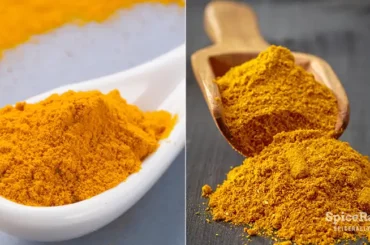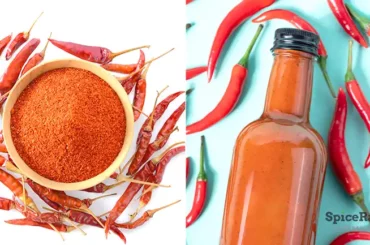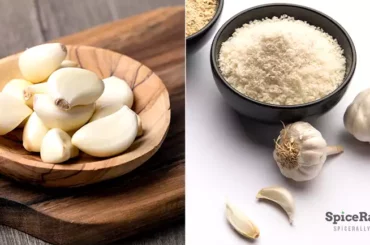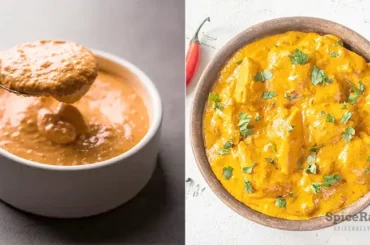Pepper, chiles, or chile pepper are very common terms, especially in savory or spicy food preparation. So, we thought of elaborating on chile pepper vs pepper to settle any confusion between these two elements.
Chile peppers are a part of the Capsicum genus, whereas peppers belong to the genus Piper. They both come from different plants and possess remarkably different characteristics in terms of shape, color, flavor, and aroma. Even though both are mainly associated with hot, savory, and spicy food preparation, chile peppers and pepper have different purposes in cooking.
Read along and refer to the table below to get a clear idea of the difference between chile peppers and pepper. We hope to have a close look on the two genera- Capsicum vs Piper.
The differences between “Chile Pepper” & “Pepper” – Spicerally drilldown!
| Chile Pepper | Pepper | |
|---|---|---|
| Genus | Capsicum | Piper |
| Types | – Cayenne – Paprika – Tabasco – Jalapeno – Bird’s eye chiles – Habanero – Poblano – Green chiles – Aji Amarillo – Scotch bonnet – Fresno – Serrano – Bell pepper – Piri Piri – Kashmiri red chiles – Ghost pepper – Carolina reaper *There are a lot more varieties of chile peppers other than the ones mentioned in the list above. | – Black pepper – White pepper – Green pepper – Cubeb pepper – Long – pepper |
| Appearance | The shape and color of chile peppers vary depending on the variety. However, most chiles are red, yellow, and green in color. | Most pepper types come as peppercorns, while long pepper is long and conical in shape. They vary in color as black, white, or green. |
| Flavor profile | The flavor of each chile varies depending on the type. They can be spicy, hot, smoky, earthy, fruity, sweet, etc. | Almost all the pepper types are peppery, earthy, piney and woody. The pepperiness depends on the variety. |
| Aroma profile | Most chile types are very neutral in the aroma. They have less piquant fragrance than pepper but can be slightly fruity, earthy, and woodsy. | Pepper is more aromatic than chile peppers. They usually possess a piquant smell with very earthy, spicy, and peppery hints. |
| Heat level | Hotter than pepper. And each type of chile has different heat levels and ranges somewhere on the Scoville Heat Scale. | They can be less hotter than most chile types. Pepper is more peppery rather than hot. However, they all consist of a moderate heat level. |
| Purpose in cooking | Ingredient, condiment | Ingredient, condiment, seasoning |
| Forms | – Fresh chiles – Dried chiles – Crushed – Powdered | – Whole peppercorns – Cracked – Ground |
| Usage in cooking | – Prominent in savory, spicy, and hot food preparations. – Ground chiles are incorporated into spice blends and seasoning mixtures. – Fresh chiles are used in curry pastes, chili pastes, sauces, salads, as a condiment or a garnish. – Some chile powders add a twist of flavor to sweet preparations and beverages. – Dried chiles and crushed chiles are incorporated into many Asian or Asian-inspired dishes. | – Prominent in savory, spicy, and hot food preparations. – Ground pepper is used to make seasoning blends and spice mixtures. – Used as a universal seasoning when mixed with salt. – Whole peppercorns are incorporated into liquid-based dishes for flavor. – Used in certain sweet food preparations and included in some beverages. |
| Part of the plant | Fruit | Berry |
| Active ingredient | Capsaicin (But bell pepper does not contain capsaicin) | Piperine |
| Plant family | Solanaceae | Piperaceae |
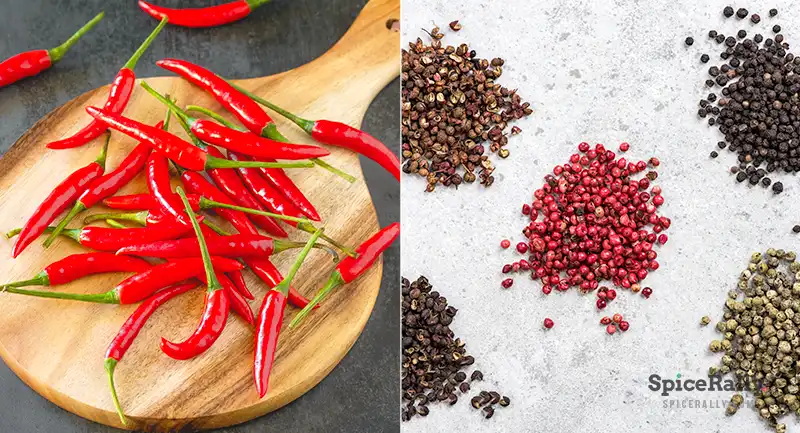
Elaborating The Difference Between “Chile Pepper” Vs “Pepper”
Chile pepper and pepper are two culinary terms that most of us get confused about regardless of our cooking experience. However, as we have presented through the table above, chile peppers and pepper DO have a clear difference in many aspects, and they have their own way of adding up to our food preparations.
The term “chile peppers,” or as most of us call them- “peppers,” are actually chiles. They are basically the fruit of the chile plant and can be incorporated into our diet fresh, dried, crushed, or powdered. On the contrary, the pepper we use in cooking is the berries of their relevant vines or plants. And they are included in the foods as whole berries, crushed or powdered.
These two ingredients impart completely different effects on our dishes. In fact, while most chile peppers give color with a “hot” and spicy accent, peppers offer a “peppery,” earthy and spicy undertone with aroma. In essence, chile peppers are typically the heat factor in a particular dish, while pepper adds depth and pepperiness more than the heat.
Can “Chile Pepper” And “Pepper” Be Used Interchangeably?
As we explained throughout our article, chile pepper and pepper possess entirely different flavors, colors, and heat levels which are considered essential factors when choosing something to be used interchangeably.
Thus, chili peppers are not a good substitute for any type of pepper and vice versa. However, they are used together in a variety of dishes since they collectively offer an incredible flavor combination in many foods. Generally, pepper backs up and enhances the spiciness provided by the chiles.

